Over the last six months or so we’ve written a number of times about Upper Harbour Dr and the saga that erupted about it after Auckland Transport moved to improve the safety of the existing cycle lanes as part of a programme to add protection to 60km of existing painted cycle lanes across the region.
The route is important as it is the only practical option for someone wanting to ride between the North Shore and West Auckland, and unfortunately will remain so for the foreseeable future. There are also plenty of plans for improved connections either side of this road.
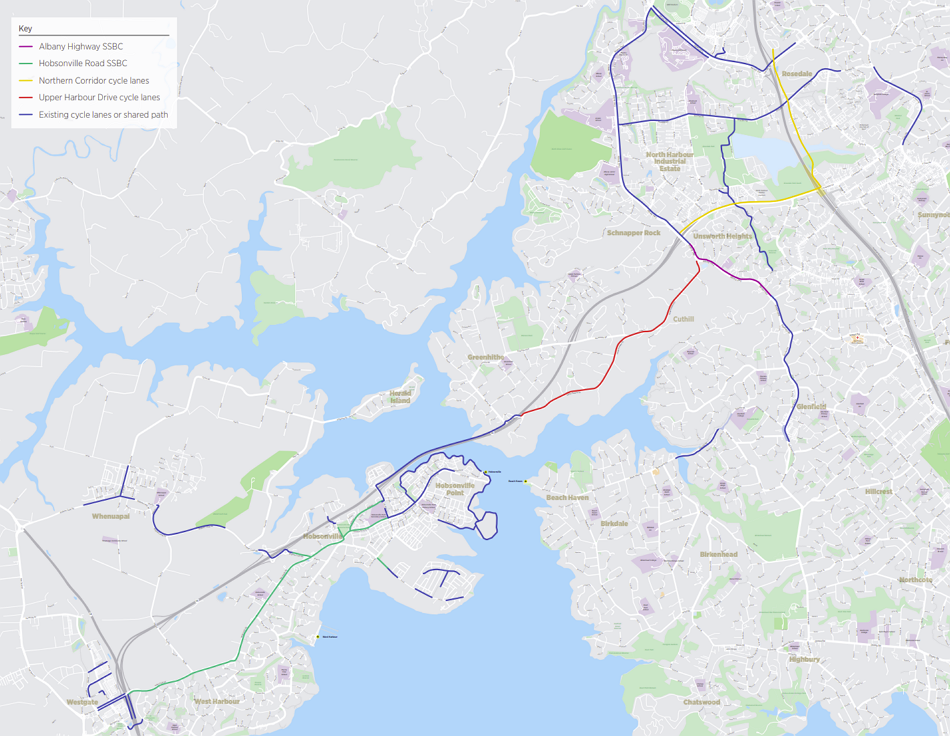
The barriers quickly highlighted why they were actually needed as after a number of vehicles crashed into them. AT have said that causes of the crashes are not consistent. Some are likely to be speed related – with my personal experience being that it wasn’t uncommon for vehicles to travel in excess of 100km/h along the route. AT have also said that one of the issues was that left gaps between the separators too large, making it easier for vehicles to stray across the edge line and hit the end of a barrier, damaging their vehicle.

Some locals have been quite vocal in demanding that the barriers be removed,
In responding to this, AT held a number of community sessions where they presented five different schemes.
- Remove the separators – deemed unacceptable from a safety point of view
- Improve the existing scheme – with various options for this such as fixing the gaps between separators, changing the type of separator, adding rumble strips etc.
- Replacing the cycle lanes with a shared path
- Narrowing the median to give more of a buffer to the separators
- Replacing the cycle lanes with a single, bi-directional cycleway.
AT have ended up looking to implement two of those.
They are currently in the process of replacing the concrete barriers with lower, easier to mount rubber barriers – this is costing about $225k plus traffic management costs.
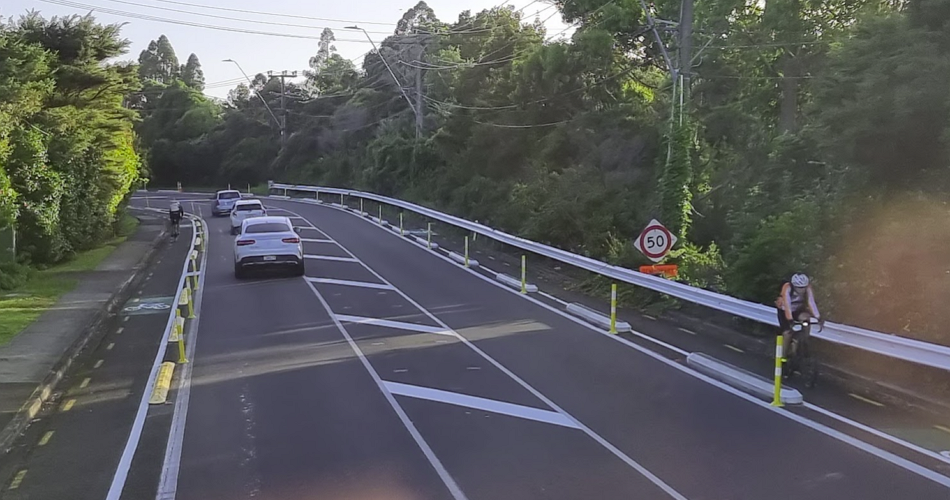
But they’re also now consulting on a proposal to spend $3.4m to replace the cycle lanes with a single, bi-directional cycleway to the eastern side of the road (right hand side on the image above), the types of separator they should use, as well as some other safety enhancements to the road such as four new raised zebra crossings and further lowering of the speed limit.
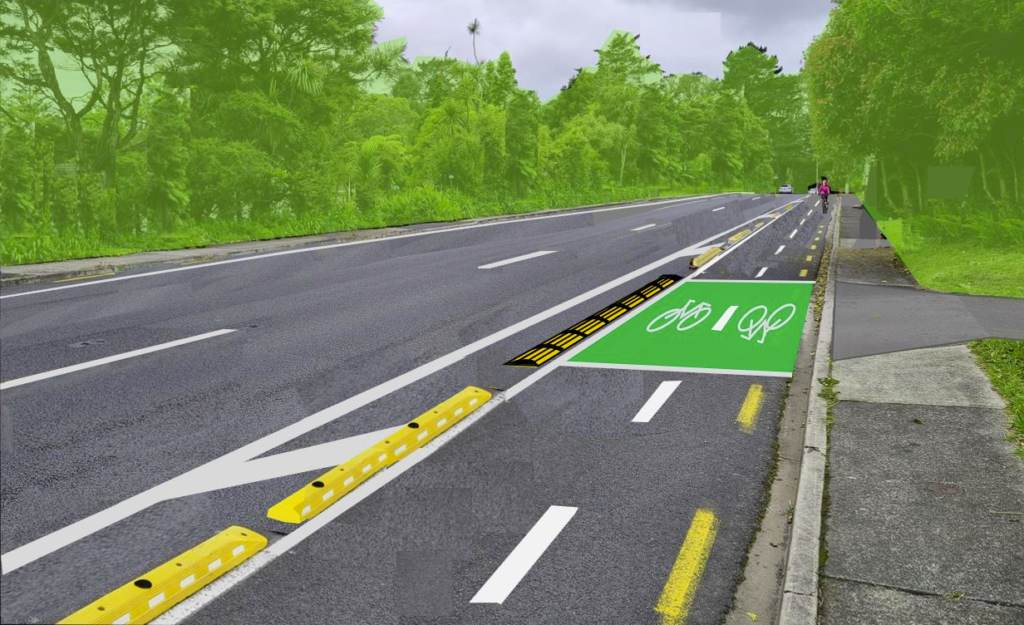
Consultation closes today and our good friends at Bike Auckland have a submission guide here.
You can also see the design documents here.
Bi-directional cycleways can have some benefits, such as making it easier for a faster rider to pass a slower one. But they have some downsides too, such as potentially being harder to access, and can have safety issues, for example a driver exiting a driveway or side road into heavy traffic may end up blocking the cycleway in both directions, or worse, not check both directions and hit a cyclist. Being wider they may also encourage illegal parking too.
Some of that access issue is being helped by the four new raised zebra crossings proposed. This should help in making the road safer, not just for bikes but for pedestrians and drivers too. Two of these are at each end of the cycleway while the other two are around the Greenhithe Rd intersection.
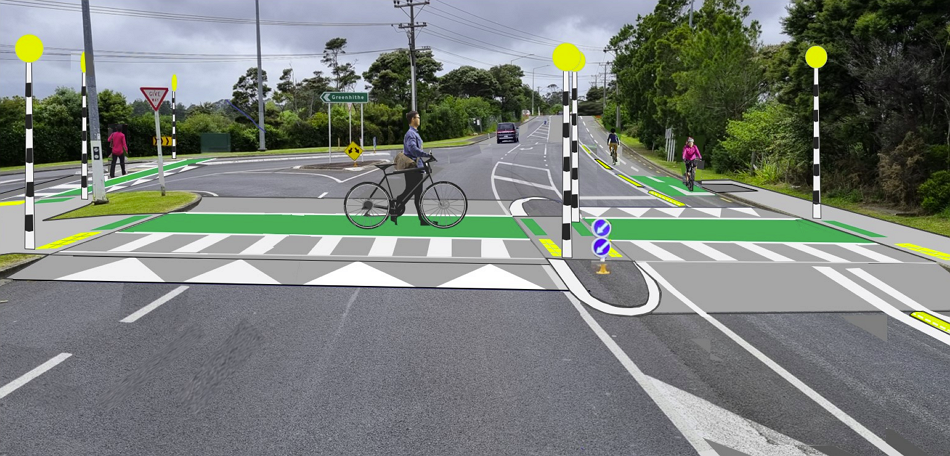
AT have also just dropped the speed limit on the road from 70km/h to 60km/h. As part of the redesign they’re proposing to drop it further to 50km/h. Those speed tables will help with this but more might be needed.
There are a couple of things about the proposal that I’m concerned about with this specific proposal.
The issues at each end
Most people who cycle along Upper Harbour Dr will travelling through, and concerningly, this proposal does nothing to fix the intersections at each end.
Southern End
At the southern end, cyclists coming from the west will still have to navigate a ~340m gap along Tauhinu Rd between the Upper Harbour Bridge shared path and this proposed bi-directional cycleway. While there are cycle lanes on Tauhinu Rd, they’re narrow and only paint, certainly not something everyone would feel safe on. AT even say on their page
- Facilities need to cater for people of all ages who would like to cycle or e-scooter, but are not confident enough.
So if AT are investing money to redesign the route, they should close this gap and making the motorway on/off-ramps safer would be an additional benefit.

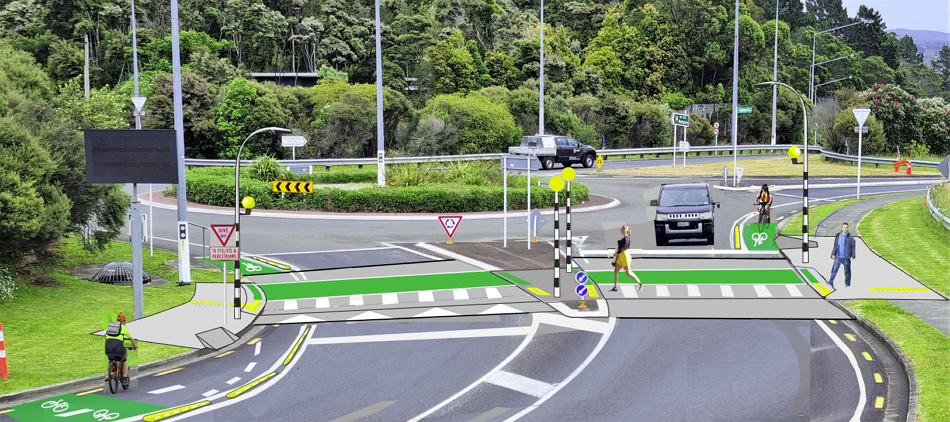
Northern End
At the northern end the bi-direction cycleway stops about 340m short of the intersection with Albany Hwy. There is not much in the way of real protection on this section either, mostly just some existing hit-sticks.
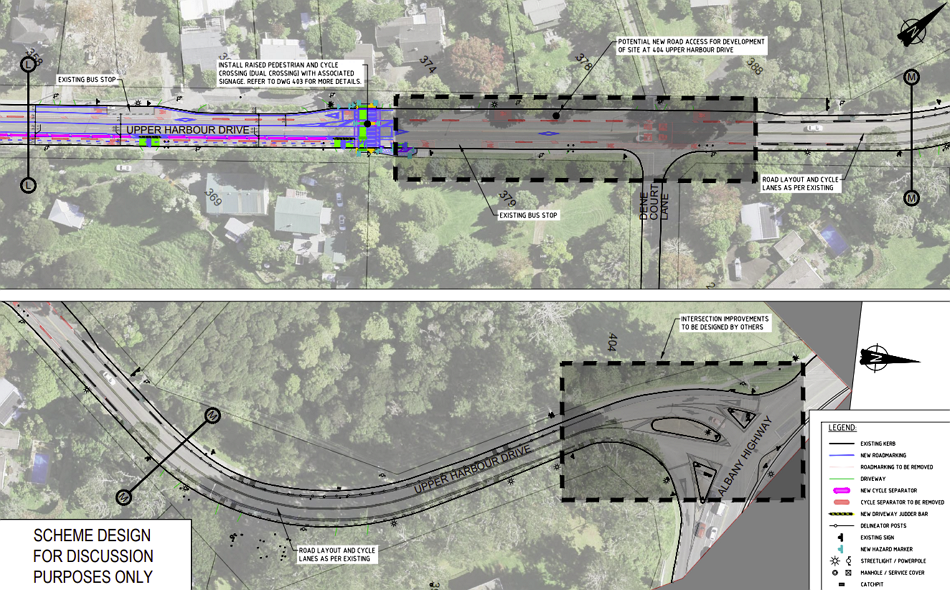
Combined with the southern end, this means for someone travelling west to north, from the end of the Upper Harbour Bridge path, will have to cross the road three times on their journey.
It’s worth noting that the Albany Highway intersection is perhaps one of the worst in Auckland for people on bikes, especially if you’re turning south with cyclists pushed into the middle of the road with traffic on either side. AT do say that they’ve got another team looking at safety improvements to this intersection but it’s unknown when we’ll see anything about this.
Narrow Lanes
The main benefit of a benefit of a bi-directional cycleway is that you get a wider cycleway, meaning it’s easier for example to pass a slower cyclist, while the total cycleway facility also takes up less space. AT are generally aiming for a 3m wide cycleway but it seems they’re dropping this to around 2.6m in places. In some cases this narrowing happens even though there’s still a painted median for cars and in at least one location this seems to be in order to add on-street parking where there has never been any before (including before the cycle lanes were put in).
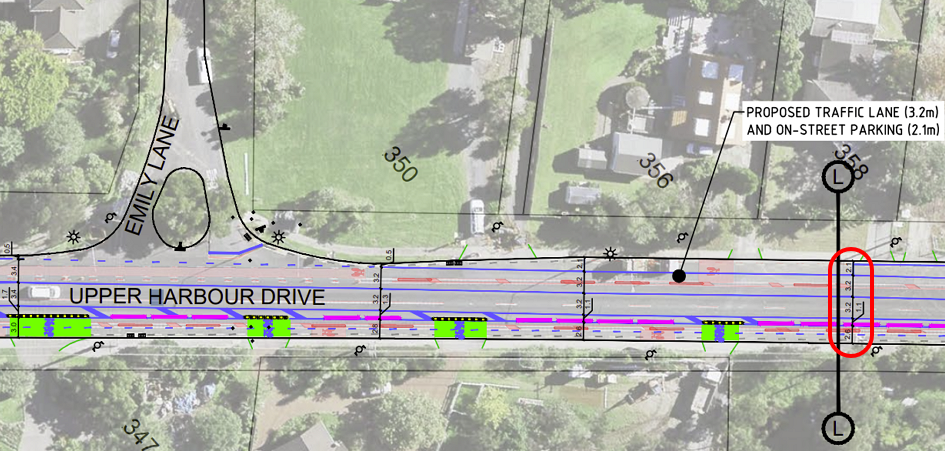
As noted above, the consultation for this redesign closes today. The survey form is very quick and can be done in only a few minutes.

 Processing...
Processing...
Does anyone know where the money for this has come from? Is it out of the pop up protection program? Maybe the cancelled bridge?
Great question. Whatever did happen to the funds from the cancelled bridge that nobody asked for?
Weren’t they meant to go towards improving the bike network?
christchurch bus improvement projects i read the other day.
A very interesting process going on here. Something tells me regardless of what the consultation reports, AT are going to to build a bi directional bike lane with weird plastic blocks that don’t stop cars.
This is the worst of all worlds, the blocks won’t provide any protection for bike users, they will still damage cars in crashes and the sports riders won’t use the lane, weirdly enraging car drivers.
Consultation is a box that AT has to tick. They don’t care what you think or whether you support or oppose something. They will simply count your submission and use the total received as evidence they consulted. It is far better to leave them to their best endeavours and then criticise the hell out them in the resulting debacle.
Use the money to improve the intersections at either end and put in the speed tables.
Anyone who crashes their car should have their licence revoked.
The road was always safe for cyclists before the barriers were put in. I always thought of it as a really quiet and safe road to ride on.
As DM posted, the issue is the intersection at the Northern end and until that is fixed, the route will always be dangerous.
I also find the stretch of road between the southern end and the western cycle path to be busy and hazardous. I’d rather see a separated path there.
Provide evidence for your statement, or expect to be banned.
It was not safe for cyclists before hand, and it is egregiously stupid to claim it was.
Lol. Agree or get banned.
No, support your claims with evidence, or get banned, “Bill”.
I made an OIA asking for information about crashes after the original cycleway went in in 2017.
There was one minor accident not causing injury.
Since the barriers went in there have been 4 cyclists crash, not involving cars, all 4 have suffered broken bones one requiring surgeory.
Feel free to email me for a copy of this OIA.
Safety isn’t determined by low DSI, but by
– appropriate counts of walking and cycling for the location, and
– objective measures of safety in the road and system design.
This stroad is not safe by either measure.
That’s probably why no one bothers to provide you with ‘evidence’ Heidi. You ignore it when it doesn’t fit your agenda.
Also, I don’t see you giving ‘evidence or ban’ demands from anyone else. So yeah, agree or ban.
The cycle lane isn’t wide enough with the fixed concrete barriers and the cyclists injured all experienced pedal strike on the barriers. Many of the residents complaining are cyclists, this is a nuanced issue and not as simple as cyclists vs drivers. The design was not fit for purpose.
If Aucklanders trying to get decent cycle ways want to lie and misrepresent residents issues vilifying them for having genuine concerns then you’re not doing youreselves any favours.
I didn’t realise you had the say on who gets banned from here Heidi.
I would say that the fact that there was only one incident recorded on this stretch of road would suggest it was safe. The fact that there has been a few incidents since the cycle barriers were installed suggests it is less safe now.
I would also suggest that my personal experience has only ever made me feel safe on this road and question if you have ever actually ridden it.
Is that enough evidence or am I getting banned?
Quote: “I would say that the fact that there was only one incident recorded on this stretch of road would suggest it was safe. The fact that there has been a few incidents since the cycle barriers were installed suggests it is less safe now.”
No, that’s not how that works, there have been many DSI’s in areas that have had no history. Why should one wait until someone is seriously injured or dead before doing anything? The “few incidents” since the protectors were added go to show there were issues happening, they are now being stopped from happening, which is great, as a cyclist veering under a car or a car veering into a cyclist is not a good thing, luckily that had yet to result in a DSI but it would have only been a matter of time. That aside there is plenty of evidence of people parking in the cycle lane before, whilst the protectors won’t eliminate it, they will reduce it which is also great. The other thing is perceived protection, I have heard from dozens who are now riding there because they feel a lot safer with the protection, even my partner loved riding there with the concrete added – wouldn’t of left the footpath before, but feels uncomfortable now that it’s reverted to plastic/rubber whilst cars zoom past well above the speed limit near constantly. I am a hardened rider that has ridden on roads with limits as high as 110 and high speed bending narrow/blind forest roads – upper harbour drive doesn’t phase me with or without protection, but I am not deluded enough to think everyone else is just like me.
Quote: “I would also suggest that my personal experience has only ever made me feel safe on this road and question if you have ever actually ridden it.”
What has made you feel safe? Unprotected painted lanes? Yeah right. Anyone who cycles knows that all painted lanes do is relegate you to the gutter, they’re arguably worse than riding a standard general lane in many cases. Add protection and then suddenly you have actual safe bike infrastructure that adds value. If you don’t like riding like that, there is always the general lane, which is the standard level of service throughout most of Auckland, so why not just use that if that is your preference. Almost everyone I have talked to in-person and online is happy with the protectors and praising them. Though I would admit I am not one to delve into local Facebook groups, as they are usually full of toxic people being trolls trying to get what they want. But I’ve seen all of their arguments and they are all based in fallacy or otherwise misleading. You would never get anything changed in Auckland if those are your benchmark.
Also quote: “have ever actually ridden it”
I have. At an average of 45km/h on my bike, back and forth numerous times with the concrete protectors to try and replicate what was being complained about, I didn’t even have to think about it. I had zero issue, even leaving the protection to pass here and there was easy going.
I even drove it, before the temporary speed drop, back and forth a few times to prove a point. I guess I would have to get drunk, play on mobile phone or doze off to replicate driving into the protectors because I couldn’t manage to hit anything whilst driving normally, even whilst trying to get as close as possible to them.
One thing I did see though over and over, was a bunch of people who couldn’t drive, they basically drove down the median with enough space for another car between them and the barrier. Whilst larger trucks and buses went through staying in their lane without issue. If they can’t judge their road position then they shouldn’t be driving, there are far narrower high speed roads throughout Auckland and the rest of the country that I would shudder to think how they cope with. If driving like that, probably they’d end up in the open drain or into an oncoming car the other way. But I guess they can’t blame concrete slabs for that, so it goes by unnoticed.
A confident group of fast-moving road cyclists were happy to use the road before the barriers. However, the high speed of traffic and lack of protection made it risky for less confident cyclists, including children. Protection is largely about increasing the range of groups who are happy and safe when cycling. The same points are raised when protection for children and other cyclists is advocated elsewhere. When there are no accidents it may be because most people consider a road too dangerous to cycle on.
God we are still going on about this road? Just move on, don’t spend more money
And how weird are the Council budget questions framed for feedback.
Standard North Shore resident complaints:
“AT don’t spend any money on the ‘Shore”
“AT keep changing things and we want them how they were”
Where am I meant to tie up my donkey when I visit the butcher?
I would like them to put in something completely new that everyone hates, take over two years to build it then before it is finished rip it out and start all over again.
Miffy, we have had two examples of that in Takapuna recently. One was a pram refuge on Lake Road that AT consulted on. I diligently studied the plans, stepped out what it might look like, and then, as part of my consultation response said that it would impede the flow of buses. I appreciate, in hindsight, that my approach was unfair: I hadn’t used pictures and had not explained what impede meant. AT, as they often do, just seemed to ignore consultation and built the pram stop that impeded buses. After 3 weeks they had to remove it.
Now they have tried a similar approach with a traffic sign on Tamaki Drive.
On my bucket list is to land a consultancy at AT where I performance manage out all those without brains.
Will people want to ride towards oncoming cars with just a bit of plastic between them and the car? Especially on a road that looks more like a highway.
I don’t know the road well but it looks like the solution is to get rid of the painted median and instead use that space to put a buffer between the road lanes and the existing concrete separators.
Yes. No median in the middle. 50km/h speed limit. Paint a median-type thing between the tim tams and the road. Spend the money on improving the intersections.
The best bit is they keep reducing the speed limit along here. Good for cyclists and also sweet, sweet motorist tears. *chef’s kiss*
I know where this is headed, it’s a “road to nowhere”,a poorly implemented “improvement” with the predictable backlash. Now AT will “double down “,with more “improvements” that will just piss more people off,bi directional,really.
The only safety gains will come from the reduced speed and the raised crossings,anything past that, AT,seem incapable of implementing.Sadly,this will set the cycle way program back years,so AT,maybe feel,they are getting the outcome they were hoping for.
I think you will find that the plastic barriers are short-term measures with the one-way cycle lanes, pending this consultation and the long-term design, as the original scheme was paused part-way through construction.
The render of the roundabout shows low-profile yellow blobs, not the sturdy concrete tim-tams that the ute-drivers of Greenhithe seem to have so much trouble avoiding.
Maybe the best feedback would be: for this part of the road, what comments do you want to make on the proposed design? And for “Other” comments, advocate for the next two missing pieces – the Albany Highway intersection and the link to the Upper Harbour Bridge path. NZTA weren’t interested in providing that link when they built the roundabout and the bridge as part of the Greenhithe Deviation motorway. Not as if NSCC didn’t tell them.
Brief submission done. It’s good we have Bike Auckland that can delve deeper into the ins and out of these projects from an experienced design/user point of view for us people that don’t use the area frequently.
Turn Upper Harbour Drive into a segment of a busway that runs from Westgate to Rosedale station. Probably end up being a quicker trip into town than getting the so called SH16 North Western ‘improvements’
Bi-directional cycle lane sound bit dangerous. If I was driving and would think the cyclist is on the wrong lane? Also what about at night time when some cyclist cycle with a bright headlight or with a flashing light might distract or confuse car driver?
Wait till you hear about car headlights! So bright! Much distraction!
The key thing is you don’t expect white lights on your left side. For similar reasons in many countries it is not allowed to park your car “backwards” against the direction of traffic.
including NZ. It seems many Brits here remain unaware of our rule, so it’s become rife in recent years.
“AT have also said that one of the issues was that left gaps between the separators too large, making it easier for vehicles to stray across the edge line and hit the end of a barrier, damaging their vehicle.”
Gosh and this came as a surprise to someone? Surely even if they found a designer who didn’t see that coming then they must have found at least one safety auditor who could?
Carlton Gore Rd ones have been there for 8 years, giant gaps in the separators… yet nobody is stupid enough to drive into them… that we know of. Probably happens but people blame the fool who crashed not the objects. It’s like crash barriers… if someone hits them, they’ve done their job, why else have them? Remove them so they can drive into the cyclist or peoples front yards instead? Genius!
Genuis! With that attitude you could install steel blades at neck height beside every road so that anyone who dares to be human gets wiped out. We could give up on frangible poles on the assumption that some people deserve to be maimed. Or maybe we should stick with a safe system approach and try and keep people safe. But on your point of Carlton Gore- you could be on to something. Maybe the people at AT figured they got away with it on a short section of straight well lit low speed city street and figured “stuff it we will put them on higher speed country roads as well”.
What on earth are you on about? You are missing the point. Someone colliding with something that avoids a more serious outcome is perfectly sensible and is very common – railings, crash barriers, fences. What you are talking about it just putting something there for the sole purpose of hurting people (steel blades at neck height) and a completely bizarre comparison.
Also no, I don’t agree, they can work anywhere, they even work on upper harbour drive just fine for the 99.9% of people not getting distracted and driving into potential cyclists in the bike lane. Hell even the harbour bridge has a pretty skinny lane sometimes when the central barriers are placed accordingly, 80km/h and one moment of distraction and you will crash into them – and many drivers have. Should we get rid of those too and let them hit oncoming cars in the other direction instead? Genius!
When we put traffic islands in we are supposed to be aware of the danger of the nose of the island. We used tapers and offsets to make them safer and we light them. Except for some reason on Upper Harbour Drive (a road that was a major safety risk for years until North Shore City and then Transit NZ spent a small fortune on to increase the width of the traffic lanes at the curves). Then along came AT and put in something they should have known was going to cause more crashes than it avoided. Now they are blundering into southbound cycles mere inches away from northbound cars and trucks. Good luck with that one. Your theory that if an island is being hit then it must be working is simply bizarre.
There’s a traffic island by way of a pedestrian refuge on my road, gets hit plenty of times, generally by speeders or intoxicated people. Doesn’t have any reflectors or anything of the sort. Everyone just leaves it down to the driver as the vast majority of people generally just look where they are going and drive past it with no issue. It’s rarely used to cross and there have been no DSI’s to pedestrians there. Yet nobody is complaining – perhaps if the drunk or otherwise distracted drivers started a big whinge on their local facebook page however, then there would be a big pile on and suddenly AT is to blame for their stupidity and the traffic islands got to go! Meanwhile AT dress it up in hitsticks and reflectors and consults on it – because they still want pedestrians to stay safe. Hmm I am detecting a pattern there. I hope they don’t set continue this stupid precedent.
“short section of straight well lit low speed city street” – yes I think this is the key difference here. Perhaps the views are distracting too and the road contours going up and down.
To me though, if they are getting hit by cars, they are doing the job of protecting the cyclist. The quality all comes down to cost and trying to save money here has ended up costing us more.
The shoulders were built at great cost specifically because of the poor crash record. North Shore City would have had institutional memory and never have removed them. I guess AT doesn’t and practically all the North Shore people left rather than work at AT. The shoulders were removed and the crashes came back. But that doesn’t excuse the lack of care over so many separate islands. A continuous kerb might have worked. Perhaps they can try that once this contraflow nonsense fails. Can you imagine how a driver might react when they see a bike light coming towards them on the left?
They’d probably just asume its a bike since its one light and think little of it. There are many roads near motorway where that would happen, plus busways like the nothern and especially the new eastern one, where this sort of thing happens.
Hell even most shared paths across Auckland have riders riding straight next to the lane “the wrong way” / “side of road”. Yet its never been an issue.
Why are we designing for stupid when it comes to cars, yet we often design for nothing when it comes to bikes. Despite the extra vulnerability.
Some people call it Vision Zero, some call it a Safe System Approach, but you can call it Designing For Stupid if you want. It is all the same really.
How is designing for stupid, vision zero? You’re just being ridiculous. None of the roads in the country would meet that criteria if it were the case.
But that does raise a few points about that topic, should it really apply to people doing outlandish things? Like backing into their garage door or a fence? Driving into the footpath kerb at speed? You could damage your car or receive minor injury from these kinds of things – but they are there for a reason…
Also, perhaps someone speeding and drunk driving fast into a power post or other car, or anything like that? Like seriously how do you prevent that? Do you want to try mitigating those things at all? Seems like a waste of energy because you just can’t cover every possibility…
My thoughts were that it was about making it safe outside of uncontrollable factors. Like when it comes to bikes it’s a warzone out there, but driving around – sure I have run into some poor road stuff and the like that could probably be made a bit safer, but nothing that feels anywhere near as dangerous as riding a bike, or even walking in some cases. The focus should be on vulnerable road users if anything.
I find the move to make the barriers lower in height, so they can be more easily driven over by cars, completely baffling. So – avoid damage to cars, but ensure that more possible straying by cars into the cycle space can take place without damage to the cars?
Why not the opposite? Put a large, high, continuous barrier between cars and cycles, with holes at the bottom so that the surface water can still drain away. Seems obvious answer to me!
Auckland Council is currently facing a massive deficit and there is huge need for projects which will benefit many and actually have community support. Why AT are looking to spend money they likely don’t have astounds me. Surely there are higher priorities for their reduced budget?
There’s nearly a billion dollars to divert from Penlink; sure it’s been carefully put into another bucket, but the Minister could divert it. If the government would inform the public properly about the congestion throughout Auckland that it will cause, Penlink would be extremely unpopular.
There’s hundreds of millions to divert from Eastern Busway. But the AT Board wouldn’t do their due diligence on the broken traffic modelling leading to the corridor widening there.
Danielle – if you want funds diverted to cover budget deficits etc, you are wasting your breath on the pennies allocated to cycling. There is literally billions of dollars going towards roading projects. You would get far better results for the same effort if you focused on those.
+ 100
How Penlink got through any prioritisation process baffles me.
I’m sure there are much better ways to spend tax payer money??? Considering the recent floods, slips, damaged roads and people cut off. the money should be used to fix those issues! Just cause the moneys there doesn’t mean you should spend it. No one wants this so called ‘safer’ initiative, You have made the road so revolting to drive and bike on and that shows by the number of accidents that have happened since you touched it. This is an embarrassment and you should be held to account. Please do your self a favor and Stop wasting money and start listening to the people.
Or we could just take away the licenses of those who can’t drive on this layout. They clearly are a danger to everyone, not just cyclists.
Does that apply to the cyclists who also had accidents with the concrete barriers too? As they only started having accidents after AT started messing with things that worked perfectly fine as is
They aren’t asking for the barriers to be removed.
Yeah, no actual cyclists are asking for them to be removed, short the select few that hit them when they dozed off, and their mates.
Hopefully they don’t visit Carlton Gore Rd any time soon because those have survived 8 years without incident. Not to mention the dozens of other places they exist. They’ll probably doze off there and hit them too and have AT start rejigging them to. What a complete circus of idiocy this all is eh?
I recall from earlier posts on this cursed location that some cyclists were injured at the very beginning when the changes were rolled out without any warning signage. If you aware of any since that, links are welcome.
Gemma Simpson – you say “You have made the road so revolting to drive and bike on” – really? Is it really so “revolting” that you cannot physically bring yourself to drive on? Does your car wildly bounce off those enormous horrid concrete pads all the time, forcing you to go slower, and almost inch slowly along the road? Really? Hmmmm… perhaps that shows that it is time you stopped driving.
Get a grip. The road used to be beautiful it’s now full of plastic crap everywhere.
Interesting. Tarmac for cars and few else….”beautiful”.
Lol the haters literally advocated for all the plastic stuff that is there now, then they sook about it. I was happy with the original concrete install. There is just no pleasing some people.
“It’s worth noting that the Albany Highway intersection is perhaps one of the worst in Auckland for people on bikes, especially if you’re turning south with cyclists pushed into the middle of the road with traffic on either side. AT do say that they’ve got another team looking at safety improvements to this intersection but it’s unknown when we’ll see anything about this”
My obvious question;
Which team?
Who?
When?
I have banged on about this enough, but I raised a request (and others have) years ago as this intersection makes most of the rest of the changes far less useful
So surely in 2023, they should be able to say who is looking at this, and their deadline to come up with a plan
I suspect it is still sitting on a desk, in a folder marked ‘too hard’. So it won’t get done until somebody gets seriously hurt or dies. Anybody working at AT should be able to do better than this. Or change job.
“So it won’t get done until somebody gets seriously hurt or dies.”
No, it won’t get done even then.
It is the worst intersection I have ever ridden through. You are completely exposed and if there is a following car well they can’t pass you so they follow closely while you pedal as quickly as you can. Both right turns are dreadful. I live in Greenhithe and I have stopped riding that way because of that intersection.
I know it well as I also cycle through there
Solution? Generally pedal down hill north away from the direction I want to go, cross over lower down if there is a gap at the lights, then pedal uphill again; still feeling horribly exposed as the road shoulder narrows while cars are zooming by at high speeds.
RIght now with heavy traffic, that intersection is even worse; I am on a motorbike, and having to be really cautious. A new ‘trick’ I saw a bunch of utes doing over the last week; traveling south towards Glenfield from Albany, they stay in right lane towards upper harbour drive, as if they are going to go right, then swerve around the traffic island and rejoin the highway a few dozen cars ahead.
Needs some police work as well as intersection redesign. I know it won’t be easy to fix, but one intersection I would be happy to see millions thrown at it.
I have had enough. Going to try council (again)
Yep, it’s a death trap waiting for its first victim.
If turning right to head up the hill towards Glenfield I wait for all the cars to go through so they’re not up my date as I peddle uphill.
And if there is a river of steel coming up the hill from Albany (that I’ll have to merge and cross through) then I cross over the two lanes and wait against the concrete barriers by the lights for a gap to appear so I can then peddle up and cross in said gap.
Pretty absurd, but much better than being victim #1.
It’d be nice if we had a bike path from Dene Court Lane, through the bush popping out on Hazel Glen st. Then you’d come out at Sunset rd lights.
It only looks like a ~200m gap through that bush. (I’m assuming it’s not privately owned)
Wouldn’t be surprised if there has already been injury; I suspect a lot of minor bike injuries and near misses just don’t get reported; most nose to tails like the accident I saw this morning on Albany ‘highway’* are not reported to police, just to insurance companies.
I have been thinking about solutions; and also came up with the idea of cutting through the back over what looks like Watercare owned land at 395 Upper Harbour Drive.
Not sure how to connect it all up though.
*highway = I really think that roads that have been bypassed as highways by motorways, needs to be renamed. It is an arterial road and not a highway which implies far higher speeds.
All these proposed barriers are pathetic for the highway.
Huh? The highway runs right next to it, it’s called SH18. The protective separators are for the local road which is no longer a “highway”.
all bike lanes need to follow motorways .. done.
Local roads just proper full coloured Yellow Paint 1.5 meters nothing else
Would you let your 8.y.o ride in traffic with just 1.5m of yellow lines?
That’s the test.
no.
I may if the culture and police made local roads actual local roads and transit roads transit roads.
local roads 30 -40 Ks MAX bike have right of way at all times. Prison for cars who hurt bikes
And transit roads. Well marked understood and 60 Kms hour
Thanks Anthony brilliant analysis there, yellow paint is super protective for cyclists against Ford rangers.
Yes, it works so well, that’s why they overtake on double yellows and park on broken yellows.
A saga is essential for AT to capture attention from cyclemongers. This is one of many benefits the AT decision making process has to offer.